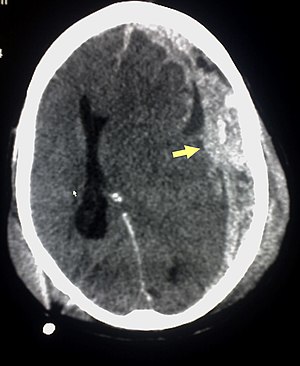Shaken Baby Syndrome
| Abusive head trauma | |
|---|---|
 |
|
| Subdural hematoma (arrow), bleeding between the dura mater of the meninges and the brain, commonly occurs in abusive head trauma | |
| Classification and external resources | |
| ICD-9-CM | 995.55 |
| MedlinePlus | 007578 |
| MeSH | D038642 |
Abusive head trauma (AHT), also known as shaken baby syndrome (SBS), is a constellation of medical findings (often referred to as a "triad"): subdural hematoma, retinal bleeding, and brain swelling which some physicians have used to infer child abuse caused by violent shaking. In a majority of cases there is no visible sign of external injury. It is a subset of the broader form of child abuse. The Centers for Disease Control and Prevention identifies SBS as "an injury to the skull or intracranial contents of an infant or young child (< 5 years of age) due to inflicted blunt impact and/or violent shaking".
The Crown Prosecution Service for England and Wales recommended in 2011 that the term shaken baby syndrome be avoided and the term non accidental head injury (NAHI) be used instead. In 2009, the American Academy of Pediatrics recommended the use of the term abusive head trauma to replace SBS.
SBS is often fatal and can cause severe brain damage, resulting in lifelong disability. Estimated death rates (mortality) among infants with SBS range from 15% to 38%; the median is 20%–25%. Up to half of deaths related to child abuse are reportedly due to shaken baby syndrome. Nonfatal consequences of SBS include varying degrees of visual impairment (including blindness), motor impairment (e.g. cerebral palsy) and cognitive impairments.
Characteristic injuries associated with AHT include retinal bleeds, multiple fractures of the long bones, and subdural hematomas (bleeding in the brain). These signs have evolved through the years as the accepted and recognized signs of child abuse and the shaken baby syndrome. Medical professionals strongly suspect shaking as the cause of injuries when a baby or small child presents with retinal bleed, fractures, soft tissue injuries or subdural hematoma, that cannot be explained by accidental trauma or other medical conditions.
...
Wikipedia
